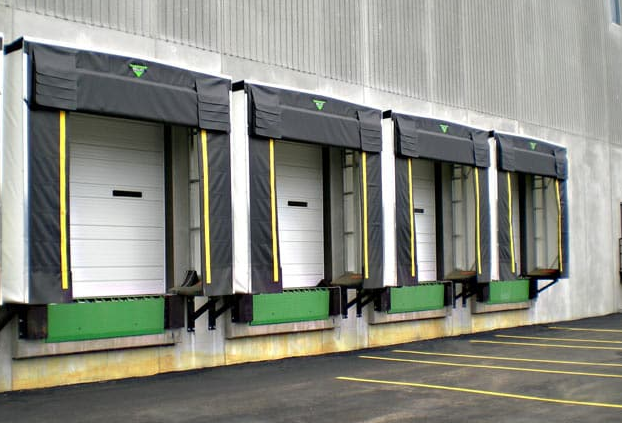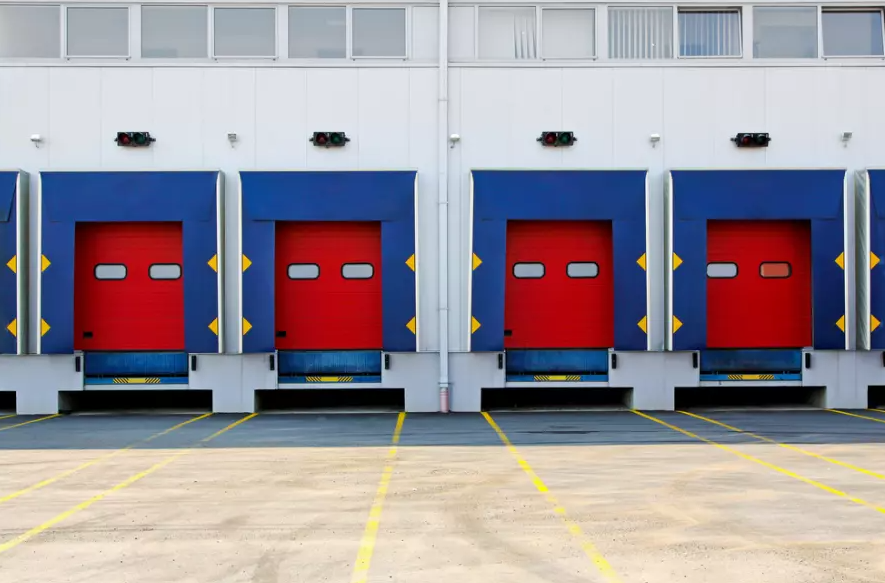The specs of a dock door include dimensions, material, mechanisms, sealing, safety, efficiency, customization options, and installation costs.
Dimensions of Dock Doors
Dock doors play a pivotal role in ensuring efficient loading and unloading of goods in various facilities. When exploring the dimensions of dock doors, several factors come into play, including the width, height, standard sizes, and customizable options. Here, we delve into the specifics of these dimensions, offering insights and price references for better understanding and decision-making.

Width and Height
The width and height of dock doors are fundamental in accommodating different sizes of goods and vehicles. Typically, the standard width of dock doors ranges from 8 to 10 feet, while the height usually falls between 8 and 10 feet as well. These dimensions ensure that a variety of trucks can easily access the loading dock.
For facilities dealing with larger or oversized goods, there may be a need for dock doors with greater width and height. The cost of installing wider and taller doors will generally be higher, given the additional materials and labor involved. For a standard-sized door, you might expect to pay between $1,000 and $5,000, depending on the material and features selected.
Standard Sizes
Standard sizes for dock doors are established to meet the needs of most facilities. The most common standard sizes are:
- 8 feet wide by 8 feet high
- 9 feet wide by 10 feet high
- 10 feet wide by 10 feet high
These sizes are designed to accommodate a variety of trucks and goods, ensuring seamless operations in warehouses, distribution centers, and other similar facilities. For facilities that adhere to standard door sizes, pricing can be more competitive, with a range typically between $2,000 and $7,000.
Custom Sizing Options
For businesses with unique needs, custom sizing options are available. Whether it’s a requirement for extra width to accommodate large machinery or additional height for stacked goods, manufacturers offer a range of customizable solutions. Custom-sized doors are often priced higher due to the specialized design and additional materials required. Prices can vary significantly based on the specifications, but they generally start from $5,000 and can go upwards depending on the complexity of the design.
When considering custom sizing, it’s essential to assess the specific needs of your facility and weigh them against the additional costs involved. Also, it would be beneficial to explore Wikipedia: Dock Door for a comprehensive overview of the various aspects of dock doors.
Material and Construction
Material and construction are vital aspects of dock doors, influencing their functionality, durability, and overall performance. In this section, we explore the common materials used, delve into frame and panel construction, and assess the durability and strength of different dock door types. Additionally, we provide price references to aid in decision-making.
Common Materials Used
- Steel: Known for its strength and durability, steel is a popular choice for dock doors. It withstands heavy impact and adverse weather conditions, making it suitable for high-traffic facilities. Prices for steel dock doors typically start around $2,000.
- Aluminum: Lightweight yet robust, aluminum dock doors are resistant to corrosion, making them an excellent option for facilities located in humid environments. Aluminum doors are generally more expensive than steel, with prices starting from $3,000.
- Polyurethane: For facilities prioritizing insulation, polyurethane is a preferred material. It provides excellent thermal resistance, helping to maintain temperature stability within the facility. The cost of polyurethane dock doors can start from $4,000.
More detailed information on these materials can be found on Wikipedia: Building Material.
Frame and Panel Construction
The frame and panel construction of a dock door are integral to its stability and functionality. The frame provides the structural support, while the panels form the door’s main body. Most dock doors feature interlocking panels and robust frames to enhance security and durability.
Depending on the complexity and materials used, the price for frame and panel construction can range between $2,500 and $10,000.
Durability and Strength
The durability and strength of dock doors are paramount, ensuring they can withstand the rigors of daily operations and environmental elements. Steel doors are often praised for their high strength and impact resistance, making them a go-to option for facilities with heavy traffic. Aluminum, while lighter, still offers commendable strength and the added benefit of corrosion resistance.
Polyurethane doors, while not as strong as their metal counterparts, provide excellent insulation, making them ideal for temperature-sensitive environments. When considering the durability and strength of dock doors, it’s beneficial to refer to Wikipedia: Material Strength for additional insights.
Dock Door Mechanisms
Understanding the mechanisms of dock doors is crucial in ensuring efficient and secure operations in warehouses and loading docks. The choice between manual and automatic, the use of overhead sectional doors, and the incorporation of roll-up doors are all vital considerations. In this section, we’ll detail these mechanisms and provide insights into their functionalities and benefits.
Manual vs. Automatic
Manual and automatic dock doors cater to different operational needs and budget constraints.
- Manual Doors: These are more cost-effective and are typically used in smaller facilities or where the frequency of door operation is lower. Manual doors require physical effort to open and close, but their simplicity means less maintenance and fewer components that could fail. Prices for manual dock doors start around $1,000.
- Automatic Doors: Offering convenience and efficiency, automatic doors are controlled electronically, usually with the push of a button. These are ideal for larger facilities with high traffic, as they save time and reduce manual labor. However, they do come at a higher cost, starting from $3,000, and may incur additional maintenance expenses.
For more details on door operation mechanisms, you can refer to Wikipedia: Door.
Overhead Sectional Doors
Overhead sectional doors are a popular choice for many facilities. Comprising of several horizontal panels connected by hinges, these doors open and close vertically, making them space-efficient as they don’t swing outward. They are known for their durability, security, and insulation properties. Overhead sectional doors are available in both manual and automatic versions, with prices typically ranging from $2,000 to $6,000 depending on size, material, and features.

Roll-up Doors
Roll-up doors, as the name suggests, open by rolling up into a coil above the door opening. The cost for roll-up doors varies, but they generally start at around $1,500.
Sealing and Insulation
The sealing and insulation of dock doors are essential aspects that contribute significantly to energy efficiency, temperature control, and protection against external elements. In this section, we will uncover why proper sealing is crucial, explore the various types of insulation, and discuss considerations around energy efficiency.
Importance of Proper Sealing
Proper sealing around dock doors is pivotal in preventing air leakage, keeping out pests, and maintaining indoor temperature. A well-sealed dock door reduces energy consumption, thus leading to cost savings on utility bills. Additionally, it helps protect goods stored near the dock from being damaged by external weather conditions. For facilities dealing with perishable or temperature-sensitive items, effective sealing is non-negotiable. Not investing in proper sealing can lead to increased operational costs and potential loss of goods.
For a better understanding of the science behind sealing, you can explore Wikipedia: Seal (mechanical).
Types of Insulation
There are various types of insulation available, each serving a specific purpose and offering different levels of thermal resistance, known as R-value. Some of the common types include:
- Fiberglass Insulation: Widely used due to its affordability and effectiveness, fiberglass insulation has a moderate R-value and is resistant to fire and moisture.
- Polyurethane Foam: Offering a higher R-value, polyurethane foam provides excellent thermal insulation and structural rigidity. It is a popular choice for insulated dock doors.
- Polystyrene Panels: These are lightweight, moisture-resistant, and offer a good balance between cost and insulation properties.
- Reflective Insulation: Made with reflective aluminum foil, this type of insulation is effective in blocking radiant heat, making it suitable for hot climates.
Each insulation type comes with its own cost implications, but investing in the right insulation can lead to long-term savings on energy bills.
Energy Efficiency Considerations
When considering sealing and insulation for dock doors, it is important to evaluate the energy efficiency gains against the initial investment. A well-insulated and sealed door minimizes the exchange of heat between the inside and outside, reducing the load on heating and cooling systems. This results in lower energy consumption and, subsequently, lower utility bills.
Assessing the facility’s specific needs, climate conditions, and energy prices will help in making an informed decision on the most cost-effective and energy-efficient solution. For a comprehensive understanding of energy efficiency, refer to Wikipedia: Energy Conservation.

Safety Features
Ensuring safety is paramount in any facility, and dock doors are no exception. The incorporation of safety features is not only a matter of compliance with regulations but also a commitment to protecting people and goods. This section discusses regulatory compliance, the role of safety sensors and alarms, and the importance of emergency release mechanisms in dock doors.
Regulatory Compliance
Adherence to local, state, and federal safety regulations is a prerequisite for any dock door installation. These regulations are in place to safeguard the well-being of workers and prevent accidents. They encompass standards on the construction, operation, and maintenance of dock doors, such as the Occupational Safety and Health Administration (OSHA) standards in the United States. Non-compliance can result in fines, legal penalties, and jeopardize the safety of the facility. For more information on safety regulations, you can refer to Wikipedia: Safety Standards.
Safety Sensors and Alarms
Safety sensors and alarms are integral components of modern dock doors, contributing to a safer working environment.
- Safety Sensors: These devices detect obstacles or personnel in the door’s path, preventing it from closing when something or someone is detected. This feature is especially crucial in high-traffic facilities to avoid accidents and injuries.
- Alarms: Alarms serve as an auditory warning system to alert workers when the door is about to close or open, allowing them enough time to move out of the way. This feature minimizes the risk of collisions and enhances overall safety.
The integration of sensors and alarms into dock doors is a small investment compared to the safety and peace of mind they provide.
Operational Efficiency
In the realm of dock doors, achieving operational efficiency is a balancing act between speed, maintenance, and durability. Facilities strive to maximize the performance of their dock doors while minimizing downtime and maintenance costs. This section delves into the speed of operation, maintenance requirements, and the lifecycle and durability of dock doors, providing insights to optimize operational efficiency.
Speed of Operation
The speed at which a dock door operates directly impacts the workflow and productivity of a facility. Faster-operating doors reduce wait times, improve temperature control, and enhance security by minimizing the time the door is open. However, speed should be balanced with safety to prevent accidents. High-speed doors often come at a premium, with prices starting at around $3,000, but the investment can be justified by the benefits in operational efficiency.
For more insights on the principles of operational efficiency, you can refer to Wikipedia: Operational Efficiency.

Maintenance Requirements
Regular maintenance is pivotal in ensuring the longevity and optimal performance of dock doors. Maintenance requirements can vary based on the type and usage of the door. Some doors may require more frequent lubrication, sensor calibration, or seal replacements. Investing in a maintenance plan and addressing issues promptly can prevent costly repairs and downtime in the future. On average, basic maintenance costs can range from $100 to $500 annually, depending on the door type and frequency of use.
Lifecycle and Durability
The lifecycle and durability of a dock door are determined by the quality of materials used, construction, usage frequency, and maintenance. Durable doors that can withstand the rigors of daily operation and adverse weather conditions offer better value over time. While more durable doors may have a higher upfront cost, they often result in lower total cost of ownership due to reduced maintenance and replacement needs. Assessing the lifecycle and the long-term costs of a dock door is essential in making an informed purchasing decision.
Customization and Accessories
Customizing dock doors is an excellent way for facilities to meet specific operational needs, enhance aesthetics, and improve functionality. From window options and color selections to additional accessories, customization allows for a tailored approach to installing dock doors. In this section, we’ll explore various customization options and accessories available in the market.
Window Options
Incorporating windows into dock doors offers several benefits, such as increased natural light, better visibility, and enhanced safety. Window options vary in size, shape, and type of glass used. Safety glass is a popular choice for its durability and ability to withstand impacts.
For more information about the types and properties of safety glass, visit Wikipedia: Safety Glass.
Color and Finish Choices
Choosing the right color and finish for a dock door is essential for both aesthetic and practical reasons. Facilities often opt for colors that match their branding or the external façade of the building. The finish, whether glossy or matte, can impact the door’s resistance to wear and tear.
Additional Accessories
Beyond the basic features, a variety of accessories can be added to dock doors to enhance their functionality and user experience. Some of the commonly available accessories include:
- Door Seals and Shelters: These accessories improve temperature control and energy efficiency by sealing gaps between the dock door and the trailer.
- Bumpers: Bumpers protect both the dock door and the trailer from impact damage during loading and unloading.
- Dock Lights: Dock lights illuminate the loading and unloading area, improving visibility and safety.
Investing in additional accessories can optimize the functionality of dock doors, although it is important to assess whether the benefits justify the additional expenditure.

Installation and Costs
The installation of dock doors is a critical phase that can impact their performance and longevity. It is equally important to understand the various cost factors and budget accordingly. This section provides an overview of the installation process, discusses the elements influencing costs, and sheds light on warranty and service contracts.
Installation Process
The installation of dock doors is a meticulous task that requires precision and expertise. The process typically involves:
- Site Assessment: Before installation, a thorough assessment of the site is conducted to identify any potential issues and ensure that the dock door specifications match the facility requirements.
- Preparation: The installation area is prepared by clearing any obstructions and marking the exact location where the door will be installed.
- Installation: Qualified technicians install the door frame, door panels, and any additional components. The door is then aligned, tested, and adjusted as needed to ensure smooth operation.
- Final Inspection: After installation, a final inspection is conducted to verify that the door is functioning correctly and meets all safety standards.
Choosing a reputable installer with experience in dock door installation is crucial to avoid any complications and ensure long-term reliability.
Cost Factors and Budgeting
Understanding the various factors influencing dock door costs is essential for effective budgeting. Some of the primary cost components include:
- Door Type and Size: The type and size of the dock door selected can significantly impact the overall cost. Larger doors and specialized types such as high-speed or insulated doors tend to be more expensive.
- Customization and Accessories: As discussed in the previous section, customization options and additional accessories can add to the total cost.
- Installation Charges: Installation charges can vary based on the complexity of the installation and the installer’s expertise.
- Regional Factors: Geographic location and local market conditions can also influence the price of both the dock door and installation services.
On average, the cost of a standard dock door, including installation, can range from $1,000 to $7,000, depending on the factors mentioned above. For more detailed pricing information and to understand how different factors contribute to costs, you may refer to Wikipedia: Cost Estimation.
Warranty and Service Contracts
A warranty is a vital consideration when purchasing and installing dock doors. A standard warranty typically covers defects in materials and workmanship for a specified period, often one year.
Service contracts may include regular maintenance, inspections, and repairs, which can extend the lifespan of the dock door and ensure optimal performance.
